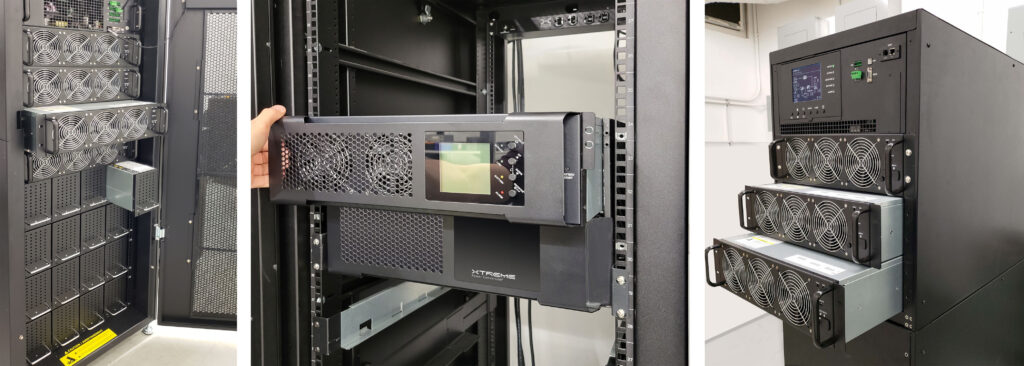Why Modular UPS Technology Matters
In the past, modularity meant adding complexity and risk. Today, modular UPS technology provides flexible building blocks that let you add, remove, or redeploy capacity as needed. This approach is driving the modern power infrastructure in data centers, colocation facilities, edge environments, and enterprise IT rooms.

From left to right: M90U-80, M90C-2S (rack mounted), M90U
Key Benefits of Modular UPS Systems
- Pay as you grow – buy only the UPS capacity you need now
- Scalable expansion – add modules without replacing the entire system
- Simplified installation – smaller, rack-mountable components reduce onsite startup
- Service flexibility – isolate small zones without shutting down the entire data center
- Smaller footprint – compact rackmount or end-of-row designs optimize space
- Lower total cost of ownership (TCO) – reduced installation, cooling, and maintenance
Distributed UPS Architecture
Modern data centers are shifting from centralized UPS to distributed and zoned UPS strategies:
- Zoned UPS – Each data hall or room is backed by its own UPS. A maintenance event only affects a single zone, not the entire site.
- Distributed UPS – Each rack or set of racks includes its own UPS, often modular and expandable. This is ideal for colocation providers who need to segment customers and scale only when demand grows.
With redundancy options such as paralleling or modularity, facilities can achieve Tier II and above reliability.
- Modularity: Multiple modules within a chassis provide internal redundancy.
- N+1 redundancy: One extra module ensures continuous uptime if a unit fails.
Modular UPS Solutions by Power Range
Modular Single-Phase UPS (6–48 kW)
- Rack-mount or free-standing chassis
- Hot-swappable modules for easy runtime and capacity upgrades
- Minimal installation, cooling, and maintenance costs
- Integrated maintenance bypass and optional output receptacle panels: L14-30R, L6-30R, 5-15/20R
- Perfect for edge computing, network closets, end-of-row racks, or large residential UPS applications
- Example: Xtreme Power M90S UPS
Compact Modular 208/120V Three-Phase UPS (5–24 kW)
- Rack-mount or free-standing chassis
- Hot-swappable modules for easy runtime and capacity upgrades
- Integrated maintenance bypass and optional output receptacle panels: L21-20R, L21-30R
- Scalable and efficient power for edge, or small data centers
- Example: Xtreme Power M90C UPS
Modular 208/120V Three-Phase UPS (15–140 kW)
- Internal redundancy with scalable configuration
- End-of-row design reduces single points of failure
- Fast deployment with smaller, modular components
- Modular battery M90-BC with individually breaker-ed strings
- Example: Xtreme Power M90U UPS
Modular 480V Three-Phase UPS (50–700 kW)
- Compact design with industry-leading footprint
- Scalable power for large enterprise and hyperscale applications
- Front-access serviceability for flexible deployment
- Example: Xtreme Power X90 UPS
Compare Modular UPS Models
| Model / Feature | Power Range | Phase / Voltage | Footprint / Mounting | Redundancy / Modularity | Key Applications | Highlights |
| M90S | 6 – 48 kW | Single-phase (208/120V) | Rack-mount (to 18kW) or free-standing | Modular internal redundancy, hot-swap modules | Edge computing, network closets, large residential | Compact, ideal for small-scale growth, optional receptacles |
| M90C | 5 – 24 kW | Three-phase (208/120V) | Rack-mount or free-standing | Modular internal redundancy, hot-swap modules | Edge, small data centers | Compact, scalable, energy efficient, optional receptacles |
| M90U | 15 – 140 kW | Three-phase (208/120V) | End-of-row / rack | Modular + internal redundancy | Data centers, critical power zones | High density, fast modular upgrades |
| X90 | 50 – 700 kW | Three-phase (480V) | Compact footprint, front servicing | Modular design, front accessibility | Enterprise, hyperscale, large infrastructure | High capacity, scalable, full serviceability |
What to Look for in a Modular, Distributed UPS
- High power density per rack with a small footprint
- Speed of deployment and ease of scaling
- Rack-mount and end-of-row installation flexibility
- Internal redundancy for serviceability
- Hot-swappable components for lower maintenance costs
- Expandable battery runtime
- Centralized monitoring via software, web/SNMP, and LCD display
Plan for the Future of Power Infrastructure
A modular UPS system gives IT and facility managers the flexibility to scale as business needs change. By combining distributed architectures with modular designs, organizations achieve maximum availability, lower costs, and simpler deployments. Future-proof your data center by investing in a scalable modular UPS solution that grows with your critical IT infrastructure.
Ready to Scale with Modular UPS Technology?
Discover how Xtreme Power’s modular UPS systems reduce risk, simplify deployment, and scale with your business. Request a Quote or Contact Our Power Specialists today. sales@xpcc.com 1 (800) 582-4524
